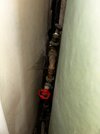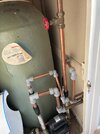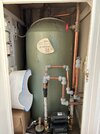We have recently moved to a flat that is run on electricity. We had a bit of a nasty shock with our last bill and are looking at ways to reduce our usage. We definitely had the heating on a bit more this month so that contributes we know but we are wondering if we can be more efficient with our immersion heater and how we use it. To be honest I don’t have a clue about these things and, having done some research am still not really any wiser. Any tips on how to set ours up? Also, why is there a panel heater and an immersion heater switch? Everything is switched on at the moment but I’m sure there is some kind of thermostat but haven’t worked out how it is set - hot water seems to run out quicker in the morning than the evening so I’m guessing it goes off over night? If I wanted to turn it off manually while I figure out the thermostat - do I turn off all switches? E.g., immersion, panel and pump?! Or just one? Thanks in advance



You are using an out of date browser. It may not display this or other websites correctly.
You should upgrade or use an alternative browser.
You should upgrade or use an alternative browser.
Immersion heater help
- Thread starter Nickyjf
- Start date
-
- Tags
- immesion heater
Sponsored Links
Much will depend which electricity tariff you are on. If you use electricity as your main heating you should be on a tariff that offers you off-peak times when the electricity is much cheaper. Economy 7 or Economy 10 for example. Your electricity bill or supplier will be able to tell you. Then it's just a matter of setting the immersion heater timeswitch below to only turn the immersion heater 'on' during the off-peak times. The main IMM SWITCH switch should be left permanently 'on' otherwise the clock on the timeswitch will stop. However there may be a possible exception described below*

Inside the immersion heater lid there will be a thermostat that once the hot water cylinder has heated up it will switch the immersion off. It's important that the hot water cylinder and the hot water pipe leaving the top of the cylinder are well insulated. That way once the water inside is hot it will stay hot, until you use it that is. It's important not to turn the immersion thermostat down too low. It needs to be at least 60C to prevent legionella.
Sorry, I've no idea about the panel heater switch and timer, it's your property you would have to tell us what it's connected to. For example, is there a heater in an adjacent bathroom? You could always switch it off and see what, if anything stops working.
*I see that you have a switch marked pump. If you have gas or oil central heating that also heats the hot water, then you should use that instead of the immersion heater. Gas is about one third the price of electricity. In this case you can switch the immersion off completely and just use the boiler to heat the water. If the switch is for shower pump etc and nothing to do with central heating, you can ignore this.
Inside the immersion heater lid there will be a thermostat that once the hot water cylinder has heated up it will switch the immersion off. It's important that the hot water cylinder and the hot water pipe leaving the top of the cylinder are well insulated. That way once the water inside is hot it will stay hot, until you use it that is. It's important not to turn the immersion thermostat down too low. It needs to be at least 60C to prevent legionella.
Sorry, I've no idea about the panel heater switch and timer, it's your property you would have to tell us what it's connected to. For example, is there a heater in an adjacent bathroom? You could always switch it off and see what, if anything stops working.
*I see that you have a switch marked pump. If you have gas or oil central heating that also heats the hot water, then you should use that instead of the immersion heater. Gas is about one third the price of electricity. In this case you can switch the immersion off completely and just use the boiler to heat the water. If the switch is for shower pump etc and nothing to do with central heating, you can ignore this.
Electric heating is about as expensive as it gets and January was cold. What you need to do is take weekly readings to get a hang on what your actual usage is. As it gets warmer outside the costs for running the home will get clearer as will the extra to heat your home.
Unless you do this you are guessing
Unless you do this you are guessing
Thanks Stem for all the info - super helpful. I thought maybe the panel heater was part of the immersion heater but I guess it’s for something else - no idea what currently but will be doing some investigating. Is a panel heater always solar panels? That is what comes up every time I google but as far as I know we don’t have any solar panels. Pump definitely for shower. Good shout about tarif - will get on that today. Cheers
Sponsored Links
Yep - learnt that the hard way. Thank you for idea of weekly readings - don’t know why I didn’t think of that! Not used to all this electric heating!Electric heating is about as expensive as it gets and January was cold. What you need to do is take weekly readings to get a hang on what your actual usage is. As it gets warmer outside the costs for running the home will get clearer as will the extra to heat your home.
Unless you do this you are guessing
Is this the right stuff?Send a picture of your cylinder and pipe work
Attachments
I thought maybe the panel heater was part of the immersion heater but I guess it’s for something else
Here's an example of a panel heater. Basically an electrically heated radiator.
Is that better? CheersInsulation on the pipes will help. But looking at that cylinder it appears not to be vented.
Can you send a picture of the whole thing
Attachments
Thanks Stem. I can’t see a panel heater anywhere in the bathroom or the rest of the flat - it’s only 1 bed. How strange….
Yep - learnt that the hard way. Thank you for idea of weekly readings - don’t know why I didn’t think of that! Not used to all this electric heating!
And record your consumption in kwh, not costs as the costs vary - this way you will get used to the expected costs!
Thanks! We have a fixed tariff - again maybe that wasn’t the best choice but I suppose it means we should get a fairly accurate view of costs?And record your consumption in kwh, not costs as the costs vary - this way you will get used to the expected costs!
Thanks! We have a fixed tariff - again maybe that wasn’t the best choice but I suppose it means we should get a fairly accurate view of costs?
You need to know your consumption in kwh - costs vary too much. The only way to make comparisons is using kwh consumption
How big is the flat and how many people live in it?
There are a few things I notice from your photo and the first is particularly worrying.
1. The casing appears to be missing from the immersion heater which means live wires are exposed.


2. As @Bod ... there doesn't seem to be a vent. That's nothing to do with the electricity consumption, more of a plumbing issue to do with venting air bubbles from the water before it gets to the taps.
3.

1. The casing appears to be missing from the immersion heater which means live wires are exposed.
2. As @Bod ... there doesn't seem to be a vent. That's nothing to do with the electricity consumption, more of a plumbing issue to do with venting air bubbles from the water before it gets to the taps.
3.
Cylinder insulation looks OK but no insulation on the hot pipesIt's important that the hot water cylinder and the hot water pipe leaving the top of the cylinder are well insulated. That way once the water inside is hot it will stay hot.
Sponsored Links
Similar threads
- Replies
- 6
- Views
- 1K
- Replies
- 3
- Views
- 2K






